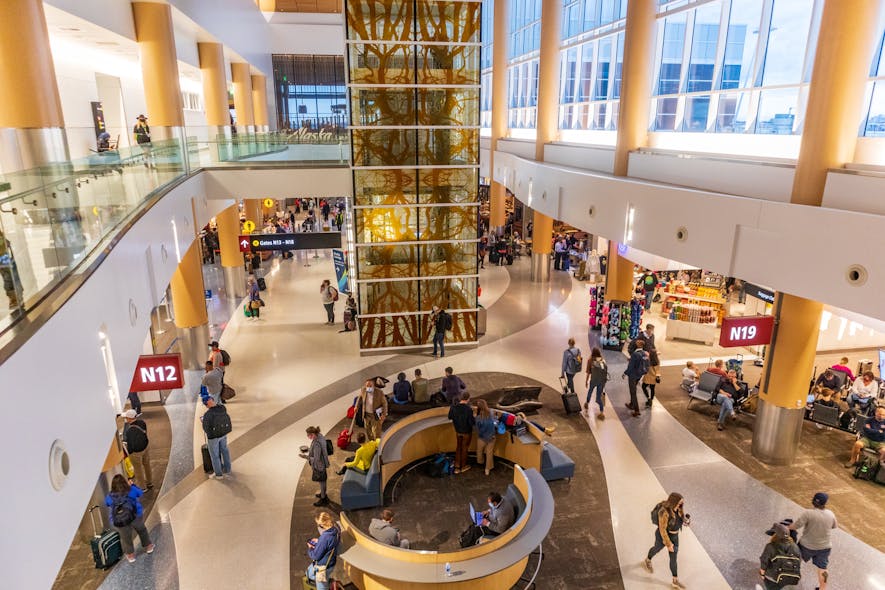
The $712 million North Satellite (NSAT) Modernization Project at Seattle-Tacoma International Airport (SEA) added eight gates, extended the building 181,000sf and renovated the existing 95,000sf. With Phase 2 opening in July 2021, the LEED Silver project was completed 3 months early, and at the start of 2022 was $32 million under budget. Today passengers are welcomed with modern amenities and Pacific Northwest-inspired art.
SEA Airport Managing Director Lance Lyttle said, “We have established a vision to be a world-class airport over the next 10, 20 years.” Along with that vision, he said, “We have set some very ambitious specific goals.”
One of those goals is becoming a 5-Star Airport certified by Skytrax, an international airport rating organization. “That’s the target we have over the next 10 years,” he said. “Recently, we were recognized as a 4-Star-rated airport, we are excited by our progress.”
Another goal is to be recognized by Airports Council International in the top 25 percent of large-hub airports for Airport Service Quality. “We want to achieve a level of service that exceeds the expectations of our travelers and creates a premier customer experience,” Lyttle said.
The NSAT Modernization Project gets the airport closer to its goals. Phase 1, which opened in 2019, included a 240-foot expansion to the west, new gates and a new Alaska Airlines lounge. Phase 2 included remodeling the old facility and 12 gates.
“This is facility is extremely important because it provides the space that we need,” Lyttle said. “It provides the lounges that we need, the hold rooms, the technology, for example, the Wi-Fi. It has concessions that we need in order to become a 5-Star-rated airport.”
The 1973 original North Satellite facility previously had had no major upgrades, and Lyttle described airport concessions as “woefully underserved.” Now, there’s an additional 26,000sf of concessions space with triple the dining and retail offerings and more to come.
Amenities include the ability to charge mobile devices from every seat in the holding areas, a pet relief area, and a nursing suite with comfortable seating, a single-use restroom, changing table and sinks.
Artwork throughout the North Satellite was inspired by the Pacific-Northwest. The build’s design was re-envisioned and reconstructed around an iconic central clerestory circulation spine. The high center roof known as “The River” moves up and down along the length of the building, reaching a height of 85 feet above the concourse floor.
The River’s ceiling is made from Forest Stewardship Council-certified beechwood and sourced from responsibly managed forests. Other features with sustainability in mind include a rainwater capture system. Rainwater is collected from the roof and used to augment flushing water in the restrooms. The facility roof receives up to 750,000 gallons of rainwater runoff, saving an estimated 2.8 million gallons of potable water each year. Energy-efficient LED lighting is used inside and outside and is estimated to save about 1.7 kW per year, which is approximately the energy consumption of 170 homes.
Lyttle concluded, “It really is kind of a snapshot of what this entire airport is going to look like in the future.”
How They Did It
The Port of Seattle, Alaska Airlines, teamed with Hensel Phelps (contractor), AECOM (architect of record), Fentress Architects (design architect), Jacobs (project manager), Heery/Parametri (construction manager) and GLUMAC (commissioning team) to deliver the construction manager/general contractor (CM/GC) project over six years.
When Phase 1 opened in January 2019, Ken Warren, SEA Airport Project Manager, North Satellite Modernization & Expansion, said, “We just kind of barely made our date.” They started resequencing the project. “We were constantly rethinking, ‘How can we save time?’” Warren said. “The whole point of that was if we can save time, we can save money. And, we were challenged in 2018 by Alaska Airlines to try to open this for summer of 2021.”
Although they were making progress, Warren said they still weren’t getting to the summer date. Then COVID-19 happened. Once the project was deemed essential, Jason Coyne, general superintendent, Hensel Phelps, and his team contacted every trade partner, superintendent and foreman who supervised the 300 workers on site to communicate the COVID-19 mitigation strategies that were being implemented. Ultimately, no work days were lost.
The slowing of airline operations during the pandemic also helped the project timeline. “It gave us the ability to maximize our work areas and eliminate some of the microphasing in order to expedite that schedule,” Coyne said.
In May 2020, there were so few passengers that the airline, port authority and Hensel Phelps figured out a way to reroute passengers to the active gates. The main passenger access into the terminal from the train was shut down. “This idea benefitted the critical path of the schedule during the pandemic,” Coyne said. It was referred to as “Operation Silver Cloud.”
Location: Sea-Tac North Satellite
Project: NSAT Modernization
Cost: $712 million (Port of Seattle’s portion)
Completion: July 2021
Key participants: Hensel Phelps, AECOM, Fentress Architects, Jacobs, Heery/Parametri and GLUMAC